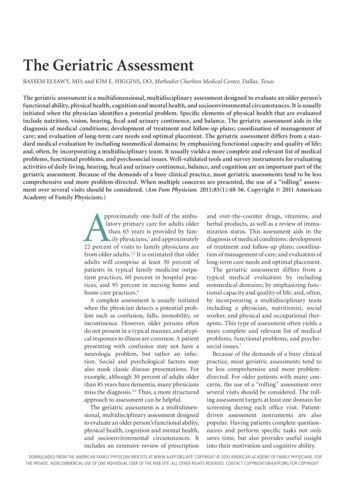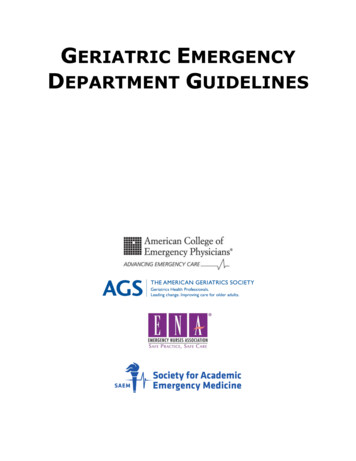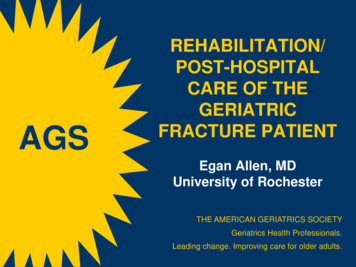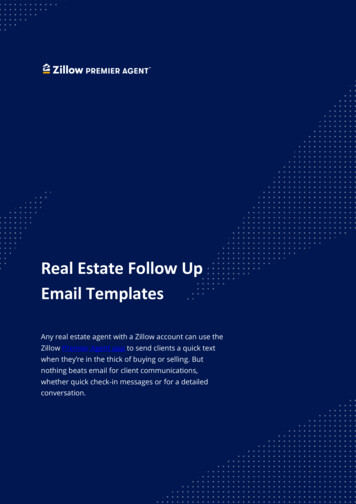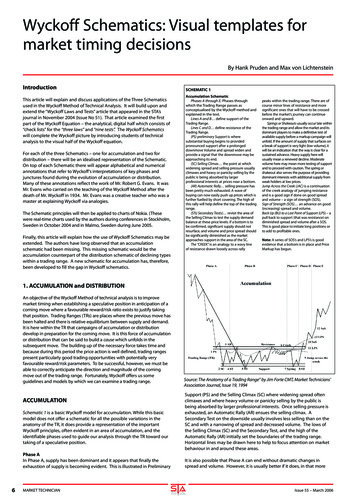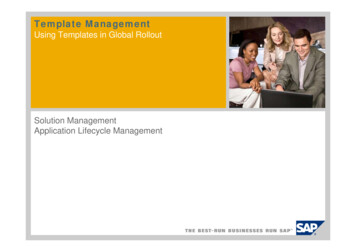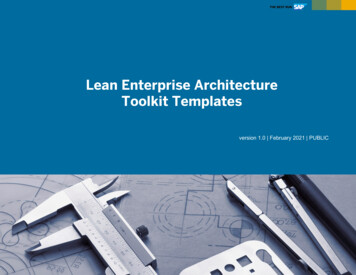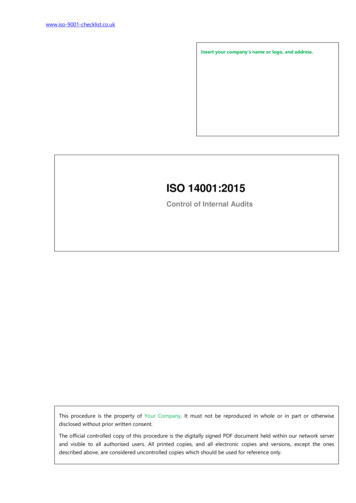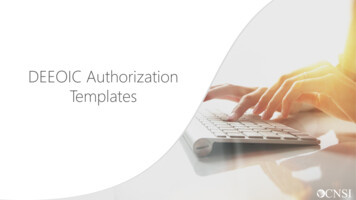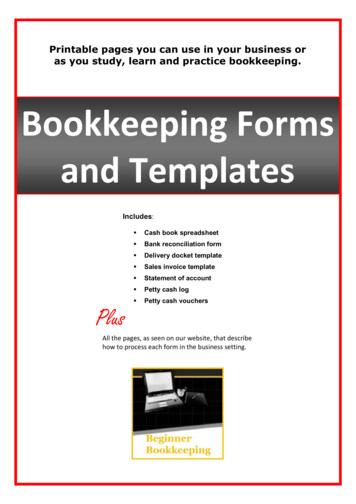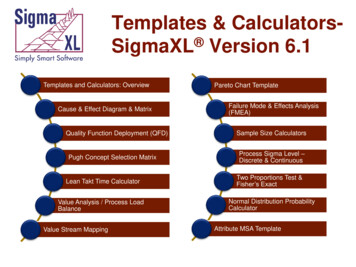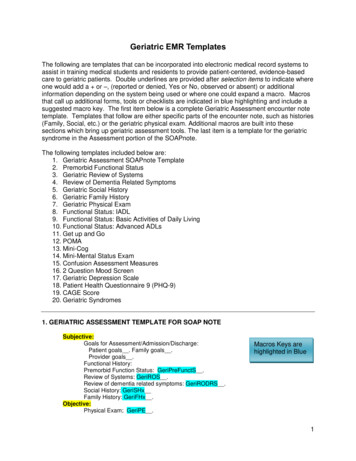
Transcription
Geriatric EMR TemplatesThe following are templates that can be incorporated into electronic medical record systems toassist in training medical students and residents to provide patient-centered, evidence-basedcare to geriatric patients. Double underlines are provided after selection items to indicate whereone would add a or –, (reported or denied, Yes or No, observed or absent) or additionalinformation depending on the system being used or where one could expand a macro. Macrosthat call up additional forms, tools or checklists are indicated in blue highlighting and include asuggested macro key. The first item below is a complete Geriatric Assessment encounter notetemplate. Templates that follow are either specific parts of the encounter note, such as histories(Family, Social, etc.) or the geriatric physical exam. Additional macros are built into thesesections which bring up geriatric assessment tools. The last item is a template for the geriatricsyndrome in the Assessment portion of the SOAPnote.The following templates included below are:1. Geriatric Assessment SOAPnote Template2. Premorbid Functional Status3. Geriatric Review of Systems4. Review of Dementia Related Symptoms5. Geriatric Social History6. Geriatric Family History7. Geriatric Physical Exam8. Functional Status: IADL9. Functional Status: Basic Activities of Daily Living10. Functional Status: Advanced ADLs11. Get up and Go12. POMA13. Mini-Cog14. Mini-Mental Status Exam15. Confusion Assessment Measures16. 2 Question Mood Screen17. Geriatric Depression Scale18. Patient Health Questionnaire 9 (PHQ-9)19. CAGE Score20. Geriatric Syndromes1. GERIATRIC ASSESSMENT TEMPLATE FOR SOAP NOTESubjective:Goals for Assessment/Admission/Discharge:Patient goals . Family goals .Provider goals .Functional History:Premorbid Function Status: GeriPreFunctS .Review of Systems: GeriROS .Review of dementia related symptoms: GeriRODRS .Social History: GeriSHxFamily History: GeriFHx .Objective:Physical Exam; GeriPE .Macros Keys arehighlighted in Blue1
Assessment:STABLE PROBLEMS:UNSTABLE PROBLEMS:Geriatric Syndrome GeriSyn .Potential Medication Interactions .Plan:Plan for each problem:Medications:ACTIVE MEDICATIONS: *started/date added **stoppedRx:OTC:Supplements/herbals:Follow Up:2. PREMORBID FUNCTIONAL STATUSKey: GeriPreFunctSPremorbid Functional Status:Prior to the onset of current change in health status, according to the following resource:Patient . Family . Chart . MD . Old records . Other .this patient’s condition was as follows:Incontinence . Urine . Fecal .Dementia . Previous MMSE score . Date .State of Consciousness . Obtunded . Somnolent . Lethargic . Confusional state . Clouding ofconsciousness . Alert . Hyperalert .Communication: Verbal . Written . Primary language .Mobility . Human assist . Cane . Walker . Wheelchair .Appetite . Sleep habits .Bed Mobility . Transfer .Toilet . W/o assistance .Bathe . W/o assistance .Dress . W/o assistance .Feed self . W/o assistance .Groom . W/o assistance .Shopping . W/o assistance .Cooking . W/o assistance .Laundry . W/o assistance .Telephone . W/o assistance .Medications . W/o assistance .Housekeeping . W/o assistance .Manage money . W/o assistance .Driving . W/o assistance .3. GERIATRIC REVIEW OF SYSTEMSKey: GeriROSGEN:Associated/Constitutional: Anorexia . Confusion . Falls . Fatigue . Fever . Hypothermia .Lethargy . Malaise . Mobility . Weakness generalized . Weight Gain . Weight Loss . .Endocrine: Cold Intolerance . Heat Intolerance .Hematologic/Lymphatic: Bleeding . Bruising . Ecchymosis . Epistaxis . Lymphadenopathy .Petechiae . Transfusions . .2
Allergic/Immunologic: Food Allergies . Recent Infection . Seasonal Allergies . MedicationAllergies . .ENT: Negative Head ears mouth nose and throat systems review . Dental or Teeth Problems .Dentures . Drooling . Dry Mouth . Gingivitis . Hearing loss . Hoarseness . JawPain . Oral Ulcerations . Otalgia . Post Nasal Drainage . Sore Throat . ProblemsSwollowing . Taste . Tinnitus . .Eyes: Blurred Vision . Eye Pain . Vision Impairment . Central vision . Peripheral vision . Nightvision . Near vision . .NECK: Negative neck systems review . Neck Limited Motion . Neck Pain . Neck Swelling .LUNGS/Respiratory: Negative lungs-respiratory systems review . Cough . Dyspnea .Hemoptysis . Orthopnea . Wheezing . .HEART/Cardiovascular: Negative HEART-CARDIOVASCULAR systems review . Chest Pain .Palpitations . Shortness of Breath . .ABD/Gastrointestinal: Negative abdominal/gastrointestinal review . Abdomen Pain . Constipation .Diarrhea . Heart Burn . Hematemesis . Hematochezia . Hernia . Melena . Nausea .Regurgitation . Bowel movement changes . Vomiting . .GENT/Genitourinary: Negative genital/urinary/rectal/breast systems review . Breast Mass .Dysuria . Hematuria . Hemorrhoids . Nocturia . Pelvic Pain . Stool Incontinence .Urinary Incontinence . Urine Flow Slow . Urine Frequency . Urine Hesitancy . UrineUrgency . .BJE/Musculoskeletal: Negative bones/joints/extremities/musculoskeletal systems review .Arthralgia . Back Pain . Heel Pain . Hip Pain . Joint Stiffness . Joint Swelling . KneePain . Leg Pain . Myalgia . .SKIN/Integumentary: Negative skin systems review . Skin Lesions . Bruising . Diaphoresis . DrySkin . Edema . Erythema . Hair Problems . Jaundice . Mole Changes . NailProblems . Pressure Ulcers . Pruritus . Rash . Tears . Locations . Varicose Veins .Other Skin Lesions . Locations . .NEURO: Negative neurological systems review . Balance . Confusion . Dizziness . Headache .Falls . Incoordination . Memory Loss . Paralysis . Paresthesias . Seizures . SpeechImpairment . Syncope . Tremor . Insomnia . .PSYCH: Negative psychiatric systems review . Agitation . Anxiety . Depressed .Hallucinations . Irritability .4. REVIEW OF DEMENTIA-RELATED SYMPTOMSKey: GeriRODRSReview of Dementia-Related SymptomsInterview caregiver.Include severity of symptom to patient and distress that symptom causes caregiver1. Delusions: Does the patient believe that others are stealing from him/her or planning to harm him/herin some way .2. Hallucinations: Does the patient hearing voices or does he/she talk to people who are not there .3. Agitation/Aggression: Is the patient stubborn or resistive of help from others .4. Depression/Dysphoria: Does the patient act as if he/she were sad or in low spirits .5. Anxiety: Does the patient become upset when separated from you . Does he/she have any othersigns of nervousness such as shortness of breath, sighing, being unable to relax, or feelingexcessively tense .6. Elation/Euphoria: Does the patient appear to feel too good or act excessively happy .7. Apathy/Indifference: Does the patient seem less interested in his/her usual activities and in theactivities and plans of others .3
8. Disinhibition: Does the patient seem to act impulsively, for example, talking to strangers as if he/sheknows them, or saying things that may hurt people's feelings .9. Irritability/Lability: Is the patient impatient and cranky . Does he/she have difficulty coping withdelays or waiting for planned activities .10. Motor Disturbance: Does the patient engage in repetitive activities such as pacing around the house,handling buttons, wrapping string, or doing other activities repeatedly .11. Nighttime behaviors: Does the patient awaken you during the night, rise too early in the morning, ortake excessive naps .12. Appetite: Has the patient lost or gained weight, or had a change in the type of food he/she likes .5. GERIATRIC SOCIAL HISTORYKey: GeriSocHxSOCIAL HISTORY:Current living situation .Marital Status .Primary CaregiverSelf . Spouse . Child . Neighbor . Personal Homemaker . Other .Children .Others in Support Group .Educational level/health literacy .Language .Hobbies .Activity/Exercise .Spirituality .Occupation/employment History .Financial Status .Insurance Type: Medicare supplement . Long term care insurance . Supplemental Security Income(SSI) . Referrer to SOCARE .Emergency contact on file .Services/Community Agencies involved in careHome health . Homemaker/Companion . Hospitalization . Nursing Home . CounselingServices . Senior Center . Adult Day Care . Meals on Wheels . Senior Meal Site .Support Group . Physical therapy . Other .Legal toolsRepresentative payee . Conservatorship . Trust . POA for Health Care . POA forFinances . Living will . Healthcare Proxy . Five Wishes . Other advanced directives .None .Diet/Nutrition StatusDietary Restrictions .Premorbid Functional Status: GeriPreFunctS .6. GERIATRIC FAMILY HISTORYKey: GeriFHxFamily HistoryThere is a family history of:Stroke .CAD/MI .Dementia .Diabetes .Parkinson's Disease .Alzheimer's disease (proven by autopsy) .4
Cholesterol (hyperlipidemia) .Depression .Alcohol Dependence .Psychiatric Illness (specify which psychiatric disorders) .Cancers .Abuse .7. GERIATRIC PHYSICAL EXAMKey: GeriPEPhysical Exam:Vital Signs: Normal . Abnormal . Orthostatic changes . (refer to Vital Signs Chart)General: General appearance . Level of consciousness . Orientation . Cooperation . Nutritionalstatus . Hygene . Mobility . Assistive devices . IV/Lines . Catheters . Pain level score .Speech quality . Mood .Skin: Rashes . Lesions . Color . Turgor . Scars . Nails . Hair . Tattoos .Eyes: Visual aids . Inspection . Vision . Fundi exam . Cranial nerves 2 3 4 and 6 .Ears: Hearing aids . Inspection . Otoscopic exam . Cerumen . Whisper test . Finger rub test .Mouth: Dentures . Inspection . Teeth . Gums . Mucosa . Tongue . Hydration . Hygene .Head and Neck: Inspection . Skin . Thyroid . JVD . Range of motion . Carotid bruit . Lymphnodes . Pharynx .Heart: PMI . Thrills . Rate . Rhythm , Murmur . Gallops . Pulses .Lungs: Inspection . Percussion . Rales . Wheezes . Rhonchi .Abdomen: Inspection . Bowel sounds . Percussion . Bruits . Tenderness . Liver .Spleen . Masses . Hernia .G/U Female: External inspection: Mons pubis . Labia majora . Labia minora . Internal inspection:Vagina . Cervix .Palpation: Uterus . Adnexa . Masses . Tenderness . Rectal exam . Breast exam .G/U Male: Inspection: Penis . Urethra . Testes . Scrotum . Palpation: Penis . Urethra .Testes . Scrotum . Masses . Tenderness . Rectal exam . Prostate .Musculoskeletal:Extremities: Inspection: Amputations . Deformities . Color . Edema . Varicosities .Palpation: Peripheral pulses .Assistive devices . Station . Stability . Symmetry . Alignment .Motor exam: Range of motion . Strength . Grasp . Tone . Crepitus . Defects .Tenderness . Masses . Fine motor skills .Gait Assessment: getupngo .Neurologic: Oriented to Date . Time . Place .Cognition: Mental status: CAM . minicog . MMSE .CN 2-12 . Sensory exam . Pain . Touch . Proprioception . Reflexes .Balance . Romberg . Nudge .Coordination . finger to nose testing . rapid alternating movements . Tremors . Abnormalmovements .Psychiatric: Mood . Affect . 2qm/PHQ-2 . PHQ9 . Judgment . CAGE .8. FUNCTIONAL STATUS: IADLKey: IADLTelephone UsageDo not use at all .Answer the phone but do not dial .Dial a few well-known numbers .Use telephone at own initiative .No access to telephone .5
ShoppingUnable to shop .Needs to be accompanied to shop .Shops independently for small purchases .Shops independently .Food PreparationNeed to have meals prepared and served .Can prepare meals but do no maintain adequate diet .Prepare adequate meals if ingredients are supplied .Plan, prepare, and serve adequate meals .HousekeepingUnable to perform any housekeeping tasks .Needs help with all home maintenance tasks .Perform light tasks(dishwashing, bed making) .Maintain house alone or with occasional assistance .TransportationNo travel at all .Travel on public transportation if accompanied .Travel alone on public transportation .Drive self .Driven by friends/relatives or taxi .MedicationsIncapable of dispensing own medications .Dispense own medication if prepared before in separate dosages .Dispense own medications without assistance .Take no medications/vitamins .FinancesDo not manage own finances .Manage only day-to-day purchases, need help with banking and check writing .Manage financial matters independently .9. FUNCTIONAL STATUS: BASIC ACTIVITIES OF DAILY LIVINGKey: ADLBasic Activities of Daily LivingA. ToiletCare for self at toilet completely; no incontinence .Needs to be reminded, or needs help in cleaning self, or has rare (weekly at most) accidents .Soiling or wetting while asleep more than once a week .Soiling or wetting while awake more than once a week .No control of bowels or bladder .B. FeedingEats without assistance .Eats with minor assistance at meal times and/or with special preparation of food, or help in cleaning upafter meals .Feeds self with moderate assistance and is untidy .Requires extensive assistance for all meals .Does not feed self at all and resists efforts of others to feed him or her .C. DressingDresses, undresses, and selects clothes from own wardrobe .Dresses and undresses self with minor assistance .Needs moderate assistance in dressing and selection of clothes .Needs major assistance in dressing but cooperates with efforts of others to help .Completely unable to dress self and resists efforts of others to help .D. Grooming (neatness, hair, nails, hands, face, clothing)6
Always neatly dressed and well-groomed without assistance .Grooms self adequately with occasional minor assistance, eg, with shaving .Needs moderate and regular assistance or supervision with grooming .Needs total grooming care but can remain well-groomed after help from others .Actively negates all efforts of others to maintain grooming .E. Physical AmbulationGoes about grounds or city .Ambulates within residence on or about one block distant .Ambulates with assistance of (check one) a) another person . b) railing . c) cane . d) walker .e) wheelchair . 1). Gets in and out without help . 2). Needs help getting in and out .Sits unsupported in chair or wheelchair but cannot propel self without helpBedridden more than half the time .F. BathingBathes self (tub, shower, sponge bath) without help .Bathes self with help getting in and out of tub .Washes face and hands only but cannot bathe rest of body .Does not wash self but is cooperative with those who bathe him or her .Does not try to wash self and resists efforts to keep him or her clean .10. FUNCTIONAL STATUS: ADVANCED ADLKey: AADLAdvanced Activities of Daily LivingWalk up and down a flight of stairs . Walk one-half mile . Perform heavy work around the house .11. GET UP AND GO TESTKey: getupngoCompletes in 14 seconds .Is the person steady and balanced when sitting upright .Is the person able to rise without assistance of the arms .Does the person start walking without hesitancy .When walking, does each foot clear the floor well .Is there step symmetry, with the steps equal length and regular .Does the person take continuous, regular steps .Does the person walk straight without a walking aid .Is the person able to sit safely and judge distance correctly .Optional:Is the person able to stand with the arms folded .When standing, is the person steady in narrow stance .With eyes closed, does the person remain steady .When nudged, does the person recover without difficulty .Does the person stand with heels close together .For a more thorough exam: POMA .12. PERFORMANCE-ORIENTED MOBILITY ASSESSMENT (POMA)Key: POMAPerformance-Oriented Mobility AssessmentBalance AssessmentChair:7
Instructions: Place a hard armless chair against a wall. The following maneuvers are tested .1. Sitting down0 unable without help or collapses (plops) into chair or lands off center of chair .1 able and does not meet criteria for 0 or 2 .2 sits in a smooth, safe motion and ends with buttocks against back of chair and thighscentered on chair .2. Sitting balance0 unable to maintain position (marked slide forward or leans forward or to side) .1 leans in chair slightly or slight increased distance from buttocks to back of chair .2 steady, safe, upright .3. Arising0 unable without help or loses balance or requires three attempts .1 able but requires three attempts .2 able in two attempts .4. Immediate standing balance (first 5 seconds)0 unsteady, marked staggering, moves feet, marked trunk sway or grabs object for support .1 steady but uses walker or cane or mild staggering but catches self without grabbing object.2 steady without walker or cane or other support .Have patient stand .Gait Assessment:5a. Side-by-side standing balance0 unable or unsteady or holds 3 seconds .1 able but uses cane, walker, or other support or holds for 4–9 seconds .2 narrow stance without support for 10 seconds .5b.Timing - seconds.6. Pull test (person at maximum position attained in #5, examiner stands behind and exerts mild pull backat waist)0 begins to fall .1 takes more than two steps back .2 fewer than two steps backward and steady .7a. Able to stand on right leg unsupported0 unable or holds onto any objects or able for 3 seconds .1 able for 3 or 4 seconds .2 able for 5 seconds .Instructions: Person stands with examiner, walks down 10-ft walkway (measured). Ask theperson to walk down walkway, turn, and walk back. The person should use customary walkingaid .Bare Floor: (flat, even surface)1. Type of surface:1 linoleum or tile . 2 wood . 3 cement or concrete . 4 other .[not included in scoring]2. Initiation of gait (immediately after told to “go”)0 any hesitancy or multiple attempts to start .1 no hesitancy .3. Path (estimated in relation to tape measure). Observe excursion of foot closest to tape measure overmiddle 8 feet of course.0 marked deviation .1 mild or moderate deviation or uses walking aid .2 straight without walking aid .4. Missed step (trip or loss of balance)0 yes, and would have fallen and two or more missed steps .1 yes, but appropriate attempt to recover and no more than two missed steps .2 none .5. Turning (while walking)0 almost falls .8
1 mild staggering, but catches self, uses walker or cane .2 steady, without walking aid .6. Step over obstacles (to be assessed in a separate walk with two shoes placed on course 4 feet apart)0 begins to fall at any obstacle or unable or walks around any obstacle or two missed steps.1 able to step over all obstacles, but some staggering and catches self or one to two missedsteps .2 able and steady at stepping over all four obstacles with no missed steps .Interpretation of Score: 25-28 low fall risk . 19-24 medium fall risk . 19 high fall risk .13. MINI-COGKey: minicogClock correct . Recall .14. MINI MENTAL STATUS EXAMKey: MMSEMini Mental Status Exam1. What is the: Year . Season . Date . Day . Month .2. Where are we: State . County . Town . Hospital/Building . Floor .3. Name 3 Objects: 1 second to say each. Then ask the patient to name all three.Give 1 point for each correct answer.0 . 1 .2 .3 .4. Serial 7's: 1 point for each correct answer.0 .1 .2 .3 . 4 . 5 .5. Ask for 3 objects repeated above:0 . 1 . 2 . 3 .6. Hold up a pencil and a watch: Ask patient what each is; 1 point for each correct identification.Pencil . Watch .7. Successfully repeats "No ifs, ands, or buts" .8. Follows this 3 stage command:"Take a paper in your right hand, fold it in half, and put it on the floor"0 .1 . 2 . 3 .9. Reads and obeys the following
Geriatric EMR Templates The following are templates that can be incorporated into electronic medical record systems to assist in training medical students and residents to provide patient-centered, evidence-based care to geriatric patients.
